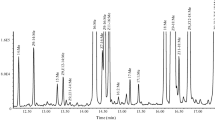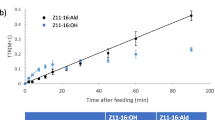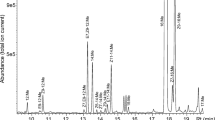Abstract.
Sex pheromones are used by insects as a form of chemical communication for the purpose of attracting conspecific mates. Female moths Cadra cautella and Spodoptera exigua use the diene (Z,E)-9,12-tetradecadienyl acetate as the major pheromone component. Biosynthesis of this pheromone component was demonstrated to occur through Δ 11 desaturation of hexadecanoic acid (palmitate) to produce (Z)-11-hexadecenoic acid which is then chain-shortened to (Z)-9-tetradecenoic acid. A unique Δ 12 desaturase uses the (Z)-9-tetradecenoic acid to produce (Z,E)-9,12-tetradecenoic acid which is reduced and acetylated to form the acetate ester pheromone component. Both moths also use a pheromonotropic peptide to stimulate pheromone biosynthesis.
Similar content being viewed by others
Author information
Authors and Affiliations
Additional information
Received 18 February 1997; received after revision 3 April 1997; accepted 9 April 1997
Rights and permissions
About this article
Cite this article
Jurenka, R. Biosynthetic pathway for producing the sex pheromone component (Z,E)-9,12-tetradecadienyl acetate in moths involves a Δ 12 desaturase. CMLS, Cell. mol. life sci. 53, 501–505 (1997). https://doi.org/10.1007/s000180050062
Issue Date:
DOI: https://doi.org/10.1007/s000180050062




